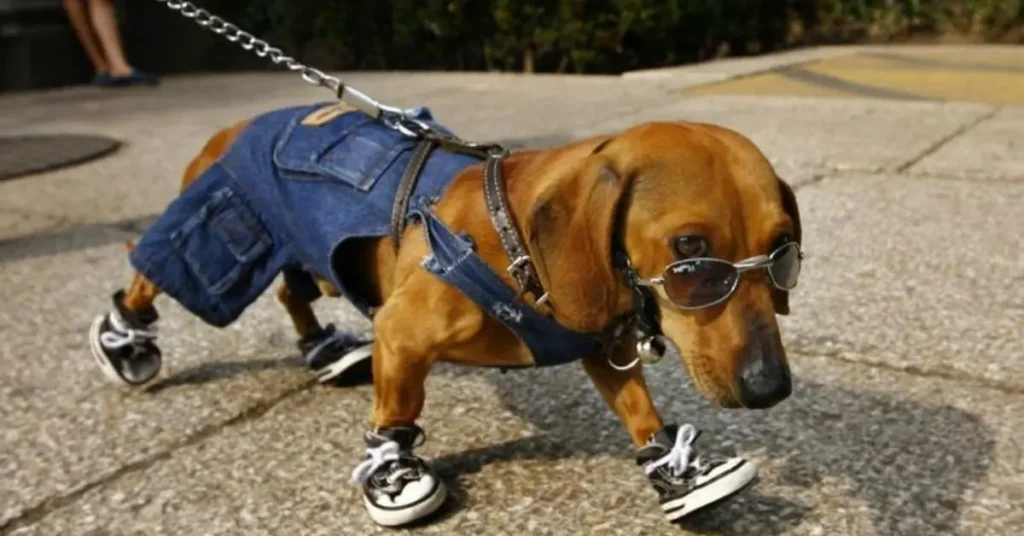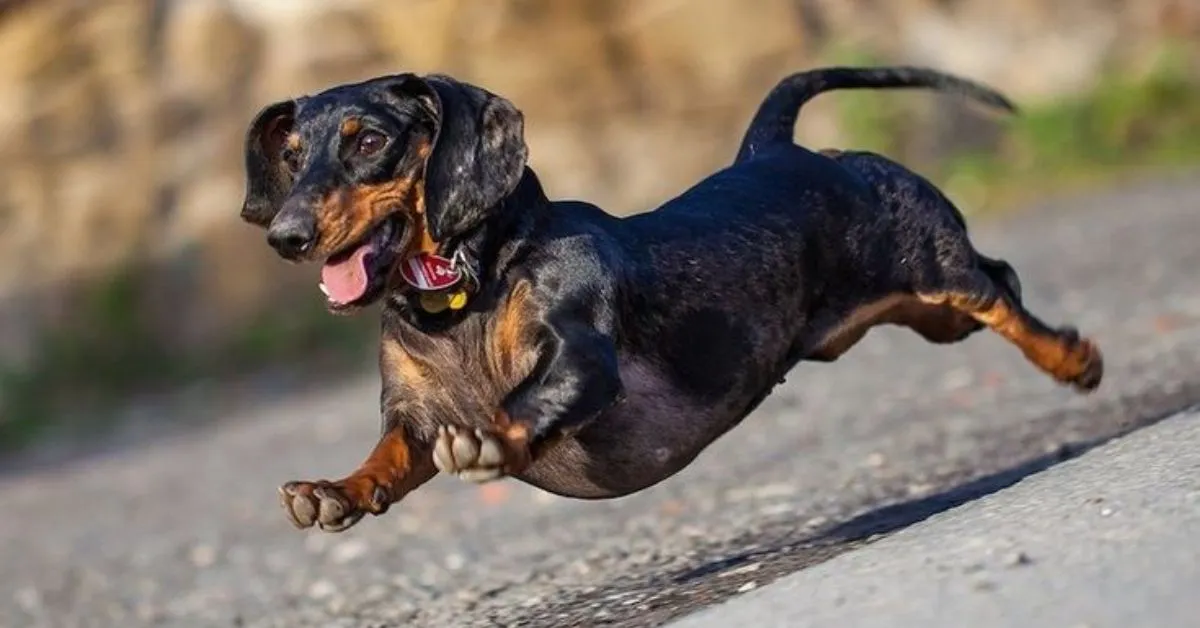Ah, the Dachshund – that lovable, sausage-shaped dog that’s been capturing hearts for generations. But hold on to your leashes, folks, because we’re about to dive into why these adorable pups sometimes get a bad rap.
Now, don’t get me wrong – I’m not here to bash our long-bodied friends. Instead, let’s explore the challenges that come with owning a Dachshund and how we can turn those “worst breed” claims into “best friend” realities.
Dachshunds Are Prone to Spinal Issues
Let’s start with the elephant in the room – or should I say, the elongated spine in the dog bed? Dachshunds, with their unique body shape, are unfortunately prone to back problems. It’s like they’re walking around with a genetic predisposition to spinal issues.
Intervertebral Disc Disease (IVDD) is the big bad wolf of Dachshund health concerns. This condition can cause pain, mobility issues, and in severe cases, even paralysis. But don’t panic just yet! While it’s true that Dachshunds are more susceptible to IVDD, there are ways to minimize the risk.
First things first, keep your wiener dog at a healthy weight. Extra pounds put unnecessary strain on that long spine. Regular, gentle exercise is key – think leisurely walks, not agility courses. And here’s a pro tip: invest in some Dachshund-specific furniture. Ramps for the couch and bed can prevent those risky jumps that might lead to injury.
Stubborn Personality
Now, let’s talk personality. Dachshunds are known for their, shall we say, strong-willed nature. These little guys have minds of their own, and they’re not afraid to use them. Training a Dachshund can sometimes feel like negotiating with a tiny, furry diplomat.
But here’s the secret: Dachshunds aren’t stubborn just to drive you crazy. Their independent streak comes from their hunting background. These pups were bred to chase badgers into their dens – a job that requires a certain level of autonomous thinking.
The key to training a Dachshund is patience, consistency, and positive reinforcement. Treat-based training can work wonders. Remember, you’re not trying to break their spirit; you’re channeling it into good behavior. Think of it as a partnership – you’re the brains, they’re the adorable brawn.
Love to Bark
If you’re looking for a quiet dog, well… a Dachshund might not be your first choice. These little hounds have a lot to say, and they’re not shy about saying it. From alerting you to the dangerous squirrel invasion in your backyard to announcing the arrival of the mail truck, Dachshunds take their vocal duties seriously.
But before you invest in industrial-strength earplugs, let’s look at why Dachshunds bark so much. Again, it goes back to their hunting roots. That loud, distinctive bark was useful for alerting hunters to their location when they were underground chasing prey.
While you can’t completely silence a Dachshund (nor should you want to), you can manage their barking. Early socialization helps reduce fear-based barking. Teaching the “quiet” command can be a lifesaver. And providing plenty of mental and physical stimulation can prevent boredom barking.
Expert Diggers
If your garden looks like an archaeological dig site, you might be the proud owner of a Dachshund. These dogs were bred to dig, and boy, do they excel at it. Your flowerbeds don’t stand a chance against a determined Dachshund on a mission.
But before you resign yourself to a life of crater-filled lawns, let’s understand why Dachshunds dig. It’s not just about making a mess (although that might be a fun bonus for them). Digging is instinctual – it’s how they hunted, how they created dens, and how they kept cool in hot weather.
Instead of fighting against this natural instinct, why not work with it? Designate a “digging zone” in your yard where your Dachshund can excavate to their heart’s content. You can even hide toys or treats in this area to make it more enticing. It’s a win-win: your dog gets to dig, and your prized petunias live to bloom another day.
Prone to Obesity

Now, let’s talk about a weighty issue – Dachshunds have a tendency to pack on the pounds. With their long bodies and short legs, extra weight can be particularly problematic for these pups. It’s not just about aesthetics; obesity in Dachshunds can exacerbate their already-present risk for back problems.
The culprit? A combination of factors. Dachshunds have hearty appetites (they were bred to fuel long hunting expeditions, after all), and their small size means it doesn’t take much extra food to tip the scales. Add in a propensity for begging (those eyes are hard to resist) and a distaste for vigorous exercise, and you’ve got a recipe for chunky Dachshund syndrome.
But fear not! Keeping your Dachshund at a healthy weight is entirely possible. It starts with portion control – measure their food and stick to recommended serving sizes. Treats should be given sparingly and factored into their daily calorie intake. As for exercise, while Dachshunds aren’t marathon runners, they do enjoy short walks and play sessions. Just remember to keep it low-impact to protect their backs.
Dachshund Health Problems
While we’ve touched on some health issues, it’s worth diving deeper into the medical challenges Dachshunds might face. Knowledge is power, after all, and understanding these potential problems can help you keep your wiener dog healthy and happy.
We’ve already discussed back problems, but let’s not forget about dental issues. Dachshunds, like many small breeds, are prone to dental disease. Their small mouths can lead to overcrowding, making it easier for plaque and tartar to build up. Regular teeth brushing (yes, it’s a thing for dogs too) and dental check-ups are crucial.
Other health concerns to watch out for include patellar luxation (a knee problem), eye issues like progressive retinal atrophy, and hypothyroidism. While this list might seem daunting, remember that not every Dachshund will experience these problems. Regular vet check-ups and a healthy lifestyle go a long way in preventing and managing health issues.
Dachshund Training Difficulties
We’ve mentioned that Dachshunds can be stubborn, but let’s delve into the nitty-gritty of training these independent-minded pups. First off, it’s important to understand that Dachshunds aren’t difficult to train because they’re not intelligent – quite the opposite, actually. These dogs are smart cookies, which sometimes translates to them thinking they know better than you.
Consistency is key when training a Dachshund. They thrive on routine and clear expectations. Short, frequent training sessions work better than long, drawn-out ones – remember, these dogs were bred for bursts of energy, not marathon hunting sessions.
Positive reinforcement is your best friend here. Dachshunds respond well to praise and treats. Harsh corrections or punishment-based training methods are likely to backfire, potentially damaging your relationship with your dog and making training even more challenging.
One particular area of difficulty? Housebreaking. Dachshunds have a reputation for being hard to potty train. Their small bladders combined with a sometimes willful nature can make for some frustrating accidents. Patience and persistence are key. Establish a consistent routine, reward successful outdoor potties lavishly, and never punish accidents – it’ll only make your pup anxious about the whole process.
Dachshund Noise & Destruction

We’ve touched on barking, but let’s expand on the noisy and potentially destructive nature of Dachshunds. These dogs can be quite vocal, and not just with barking. They’re known for their range of vocalizations, from howls to whines to a unique sound often described as “yodeling.”
As for destruction, well, those digging instincts we mentioned earlier don’t always stay in the yard. A bored or anxious Dachshund might decide your couch cushions make an excellent substitute for soil. And let’s not forget about their love for chewing – those long jaws and sharp teeth can do a number on your favorite shoes if given the chance.
The key to managing these behaviors is twofold: prevention and redirection. Provide plenty of appropriate chew toys and rotate them regularly to keep things interesting. Puzzle toys can help satisfy their need to “hunt” and keep them mentally stimulated. As for noise, while you can’t eliminate it entirely, you can work on teaching a “quiet” command and rewarding calm behavior.
Dachshund Friendliness & Sociability
Now, let’s address the elephant in the room – or should I say, the other dogs in the park. Dachshunds have a bit of a reputation for not playing well with others. It’s not that they’re inherently unfriendly; it’s more that they often have a “big dog” attitude in a small dog body.
Early socialization is crucial for Dachshunds. Expose them to a variety of people, animals, and situations from a young age. This helps prevent fear-based aggression and teaches them appropriate social behavior. Remember, though, that even a well-socialized Dachshund might not be the life of the doggy party. They often prefer the company of their human family over other dogs.
Speaking of family, Dachshunds can be prone to separation anxiety. They form strong bonds with their people and can become distressed when left alone. Gradually accustoming your Dachshund to alone time from a young age can help prevent this issue.
The Bright Side of Dachshund Ownership
Now that we’ve covered the challenges, let’s talk about why, despite these potential drawbacks, Dachshunds continue to be beloved pets worldwide. These dogs are fiercely loyal, often forming strong bonds with their families. They’re also incredibly brave – remember, they were bred to face off against badgers!
Dachshunds are intelligent and can excel at various dog sports when properly motivated. Their compact size makes them adaptable to different living situations, from apartments to large homes with yards. And let’s not forget their undeniable charm – those long bodies, floppy ears, and expressive eyes are hard to resist.
With proper care, training, and understanding, the “worst breed” can become the best friend you’ve ever had. It’s all about embracing their unique qualities and working with, not against, their natural instincts.
Choosing the Right Dachshund for You

If you’re considering adding a Dachshund to your family, it’s important to do your homework. There are three coat varieties (smooth, wire-haired, and long-haired) and two sizes (standard and miniature). Each has its own grooming needs and slightly different temperaments.
Consider adopting from a rescue organization. Many Dachshunds end up in shelters because their owners underestimated the care they require. By adopting, you’re giving a deserving dog a second chance, and you’ll often get a more accurate picture of the dog’s personality.
If you decide to go through a breeder, choose one who prioritizes health and temperament over appearance. Ask about health clearances for common Dachshund issues like IVDD and eye problems.
Adapting Your Home for a Dachshund
When bringing a Dachshund into your life, it’s crucial to make your home a safe and comfortable space for these long-bodied pups. Their unique shape and potential for back problems mean some home modifications might be in order.
First, consider investing in ramps or stairs for furniture and beds. This allows your Dachshund to join you on the couch or in bed without risking injury from jumping. Look for options with gentle inclines and non-slip surfaces for maximum safety.
Next, think about your flooring. Slippery surfaces like hardwood or tile can be challenging for Dachshunds, potentially leading to injuries. Area rugs or non-slip mats in high-traffic areas can provide better traction and peace of mind.
When it comes to toys and chews, opt for size-appropriate options. While Dachshunds might think they’re big dogs, their mouths are still relatively small. Avoid toys that could pose a choking hazard or strain their jaws.
Lastly, consider your storage habits. Dachshunds are notorious for their ability to reach things you thought were safely out of the way. Keep potentially harmful items like cleaning supplies, medications, and certain foods well out of reach.
The Dachshund Diet: Nutrition for Optimal Health
We’ve touched on the importance of maintaining a healthy weight for Dachshunds, but let’s dive deeper into their nutritional needs. A well-balanced diet is crucial for managing weight, supporting spine health, and preventing other health issues.
Dachshunds benefit from high-quality protein sources to maintain muscle mass, which is important for supporting their long backs. Look for dog foods that list a specific meat (like chicken, lamb, or fish) as the first ingredient, rather than meat by-products or fillers.
While Dachshunds need some fat in their diet for energy and coat health, it’s important not to overdo it. Excess fat can lead to weight gain, which puts strain on their backs and joints. Opt for foods with moderate fat content and avoid high-fat treats.
Glucosamine and chondroitin supplements can be beneficial for joint health, particularly as your Dachshund ages. Always consult with your vet before adding any supplements to your dog’s diet.
Remember, portion control is key. Even the healthiest dog food can lead to weight gain if overfed. Use measuring cups to ensure accurate portions, and adjust based on your dog’s activity level and body condition.
Exercise and Mental Stimulation for Dachshunds

While Dachshunds aren’t known for their athleticism, regular exercise is still crucial for their physical and mental well-being. The key is finding the right balance – enough activity to keep them fit and stimulated, without risking injury to their sensitive backs.
Short, frequent walks are generally better than long, strenuous hikes. Aim for 20-30 minutes of gentle exercise daily, split into two or more sessions if possible. Swimming can be an excellent low-impact exercise for Dachshunds, as it provides a full-body workout without putting stress on their joints.
Mental stimulation is just as important as physical exercise for these intelligent dogs. Puzzle toys, scent work, and training sessions can help keep their minds sharp and prevent boredom-related behaviors like excessive barking or destructive chewing.
Remember, every Dachshund is unique. Some may have more energy than others, and exercise needs can change with age. Always monitor your dog for signs of fatigue or discomfort during activity.
Grooming Your Dachshund: More Than Just a Pretty Coat
Grooming needs for Dachshunds can vary depending on their coat type, but all require regular care to look and feel their best. Smooth-coated Dachshunds are relatively low-maintenance, needing just weekly brushing and occasional baths. Wire-haired and long-haired varieties require more frequent brushing to prevent matting and tangles.
Don’t forget about nail care. Dachshunds’ nails grow quickly, and overgrown nails can affect their gait and potentially lead to back problems. Aim for monthly nail trims, or more frequently if you hear their nails clicking on hard floors.
Dental care is crucial for Dachshunds, given their predisposition to dental issues. Daily tooth brushing is ideal, but even a few times a week can make a significant difference in preventing dental disease.
Regular grooming sessions are also an excellent opportunity to check for any lumps, bumps, or skin issues. Early detection of health problems can lead to more effective treatment, so make grooming a consistent part of your Dachshund care routine.
The Social Life of a Dachshund: Managing Interactions
While we’ve discussed the potential challenges of Dachshund sociability, it’s important to remember that with proper training and socialization, these dogs can be friendly and social creatures. The key is understanding their unique perspective on the world.
Dachshunds often have a bit of a Napoleon complex – they don’t seem to realize how small they are. This can lead to them being overly bold or even aggressive with larger dogs. When introducing your Dachshund to other dogs, start with calm, well-socialized dogs of a similar size. Always supervise interactions and be ready to intervene if needed.
With people, Dachshunds are often devoted to their families but can be wary of strangers. Encourage positive interactions by having visitors offer treats and speak in calm, friendly tones. Never force your Dachshund to interact if they’re showing signs of discomfort.
Remember, socialization is an ongoing process. Regular exposure to different people, animals, and environments throughout your Dachshund’s life can help maintain their social skills and confidence.
Living Your Best Life with a Dachshund

Owning a Dachshund isn’t always a walk in the park (though walks in the park are definitely recommended), but for many, the joys far outweigh the challenges. These dogs have a way of worming into your heart – pun fully intended.
Remember, no breed is perfect, and no dog is a lost cause. With patience, understanding, and a good sense of humor, you can turn those “worst breed” moments into cherished memories. After all, life’s too short for boring dogs, and with a Dachshund, you’re guaranteed an adventure every day.
So, are Dachshunds really the worst breed? Not by a long shot. They’re just… unique. And in the world of dog ownership, unique can be pretty wonderful. Just ask any Dachshund owner – they’ll tell you that life is better with a wiener dog in it.
Read More Blogs On: Trendyloams
FAQ’s
What is the downside of Dachshunds?
Dachshunds are prone to back problems due to their long spine and can be stubborn, making training challenging. They also tend to bark excessively, love to dig, and are at risk for obesity if not properly exercised and fed.
Are Dachshunds one of the most aggressive dogs?
Dachshunds aren’t inherently aggressive, but they can be territorial and may show aggression if not properly socialized. Their bold personality can sometimes lead to confrontations with larger dogs, but early training and socialization can effectively prevent aggressive tendencies.
Why do Dachshunds have so many problems?
Dachshunds’ unique body shape predisposes them to spinal issues, while breeding for specific traits can lead to genetic health problems. Their strong-willed nature and hunting instincts can also result in behavioral challenges like excessive barking and digging.
Why are Dachshunds so disobedient?
Dachshunds were bred to think independently while hunting, which can make them appear stubborn or disobedient. They often prioritize their own interests over commands, but consistent, patient training using positive reinforcement can significantly improve their obedience.
Conclusion
While Dachshunds may present some unique challenges, they’re far from being the “worst breed.” With understanding, patience, and proper care, these charming, brave little dogs can make wonderful companions. Their loyalty, intelligence, and undeniable cuteness have won over dog lovers for generations, and will likely continue to do so for many more to come. So, if you’re up for a bit of a challenge and a lot of love, a Dachshund might just be the perfect addition to your family.

